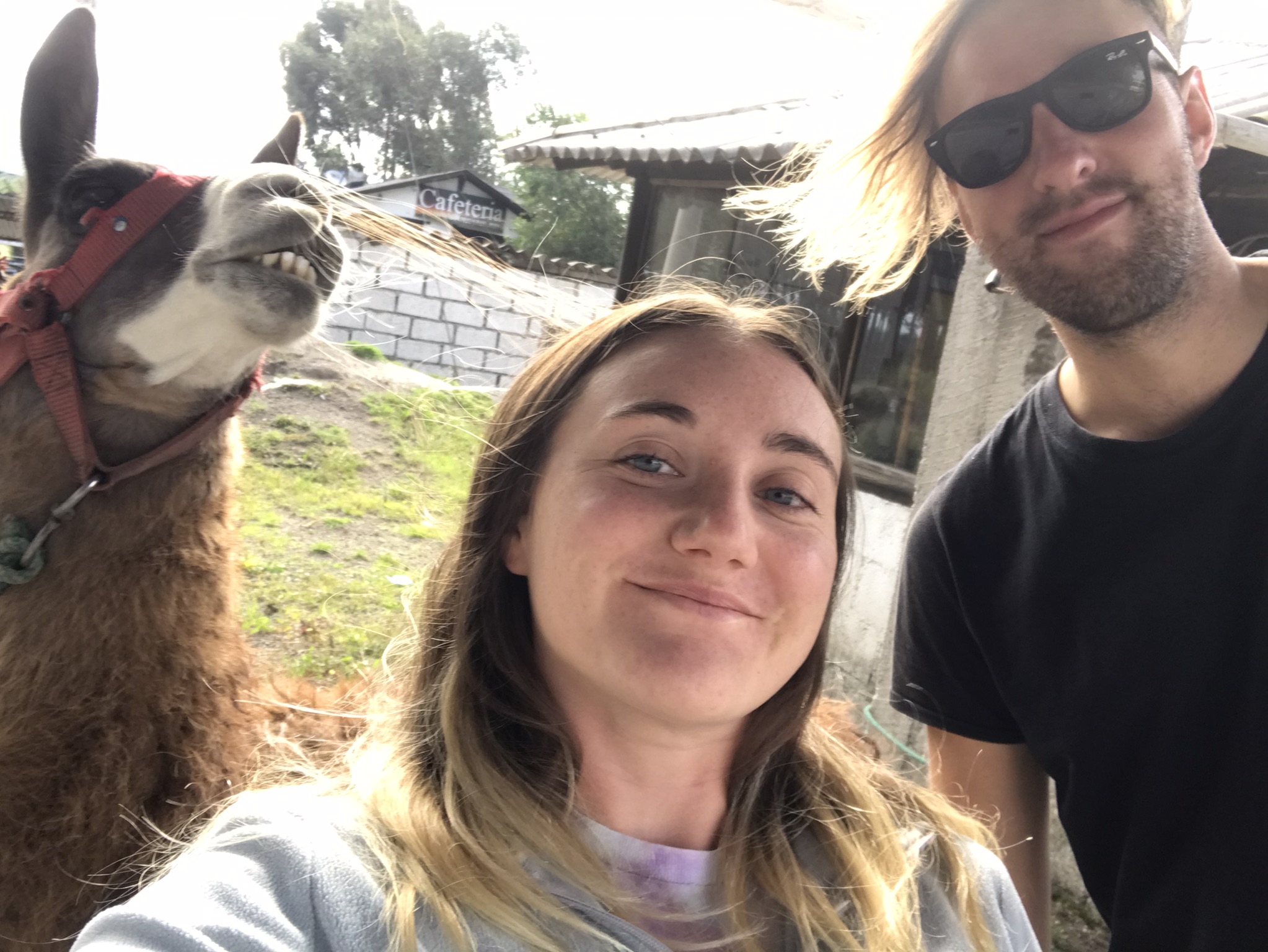Paraguay was a mystery to us. We knew very little about the country before we found ourselves standing at Asuncion bus terminal, backpacks on backs, ready to roll. When it came to researching things to do and travel routes, bus timetables etc we found it difficult to find up-to-date, reliable info. Paraguay travel was a bit of a black spot. There aren’t many tourists or backpackers here, you’re pretty much on your own! We loved this aspect. It’s important to note that the official language here is NOT Spanish, it’s the indigenous Guarani language. Guarani is taught in schools and spoken in the street but most people also speak Spanish too. We also found that when locals did try to talk to us, it was usually in German!
Asuncion, Filadelfia, Encarnacion
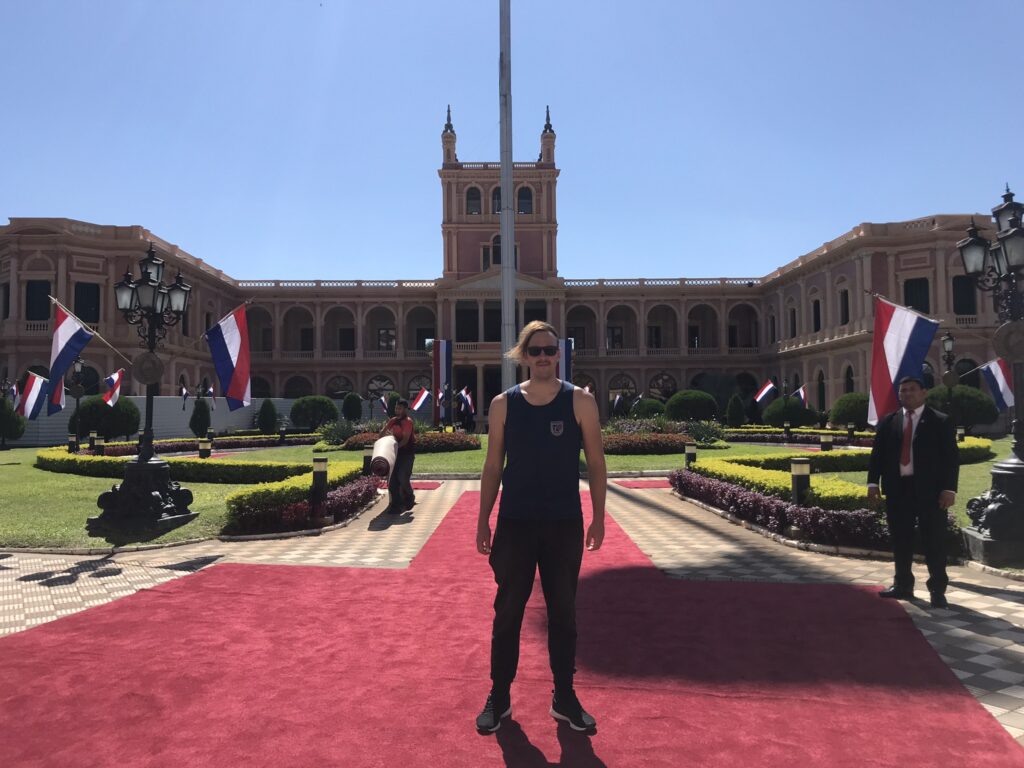
Getting to Paraguay
If you’re not flying into Asuncion and are planning to travel to Paraguay by land, the first difficulty you’ll face is how to get into the country. Paraguay is mostly surrounded by rivers with few easily-accessible settlements in other countries nearby.
The most common entry points to Paraguay are either at Encarnacion, which is linked via a bridge from the city of Posadas in Argentina, or at Ciudad del Este, which is part of a tri-border area with Brazil and Argentina and is linked to the Brazilian city of Foz do Iguacu by bridge. A little further down the river from Ciudad del Este and Foz is Puerto Iguazu in Argentina, but there is no direct road route between Puerto Iguazu and Ciudad del Este without first crossing through Brazil.
Buses do run from Puerto Iguazu to Ciudad del Este, crossing the Brazilian border in the process, however there is also a boat crossing directly from Puerto Iguazu to Paraguay which bypasses going through Brazil. We were traveling from Puerto Iguazu and opted for the boat crossing, mainly to save time and also avoid having to pass through immigration multiple times. If you do get the bus to Paraguay from Puerto Iguazu, make sure to tell the driver that you need to stop at immigration. This tri-border area can be considered a ‘free travel zone’ and we heard that the bus from Puerto Iguazu to Ciudad del Este doesn’t always stop at the Paraguayan border for locals to get passport stamps Which of course can be a nightmare for tourists who do need the stamps.
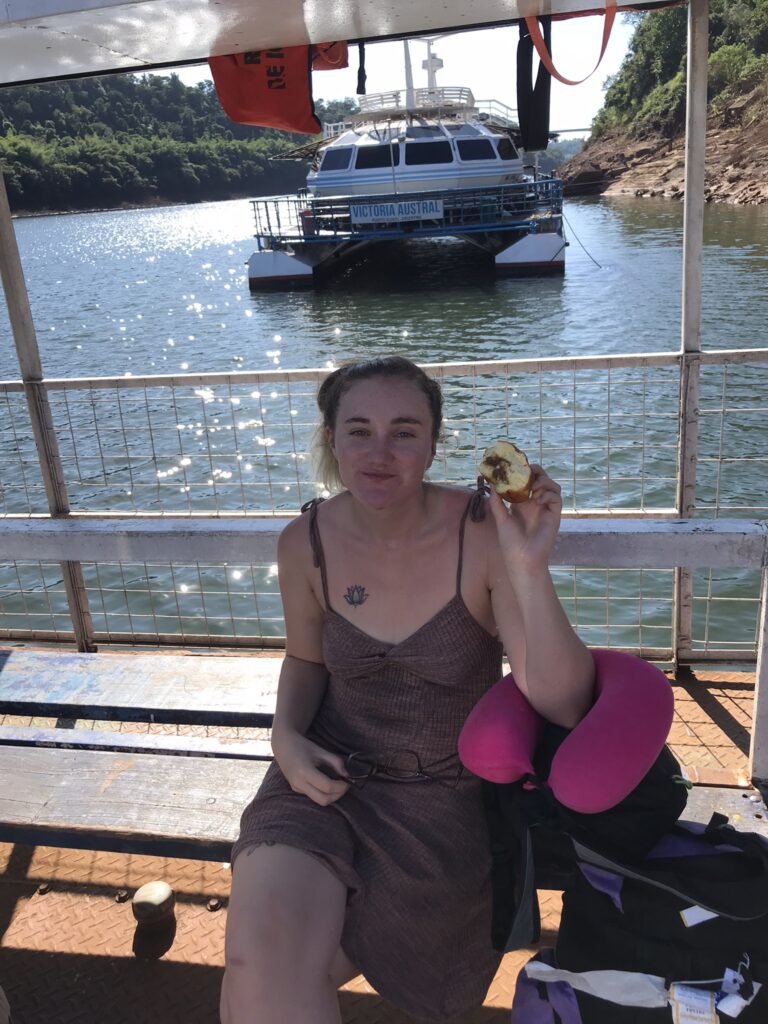
On the ferry to Paraguay with a dulce de leche doughnut
To get the river boat to Paraguay from Puerto Iguazu, head to the location ‘Ferry boat to Paraguay’ (at -25.593262680744814, -54.57860824922787 on google maps,) buy your ticket and go through the Argentinian immigration and border security. It’s a little cabin next to the ticket office. You’ll then be able to walk down the hill and board the ferry on foot, crossing the Parana river and three frontiers point on the way to Paraguay. It’s worth mentioning that this river crossing is not touristy AT ALL. The boat mainly transports vehicles and is basically a large metal raft with no roof and a long bench at one side for the passengers to sit. You’ll probably find that you are the only gringo on the ferry. The boat arrives a few miles south of Ciudad del Este at a place called Presidente Franco. When you reach the Paraguayan side of the river, get your entry stamp and hope there’s a taxi waiting. We were lucky that we were able to jump into an (unmarked) taxi straight away that was pointed out to us by the Paraguayan border police. If there is nobody there waiting you might have to wait a while or ask the border guards to call a taxi for you, I believe there might also be a bus between Presidente Franco and Ciudad del Este but we didn’t wait around to figure this out.
We took the decision to bypass staying in Ciudad del Este and get the first bus to Asuncion. Ciudad del Este is mainly known by locals as a shopping town as it is a cheap haven for counterfeit clothes which are then smuggled into Argentina and Brazil. We’d been told by our local Paraguayan friend that Ciudad del Este wasn’t very pretty and not to judge Paraguay by it. From our brief glance out of the window, I can confirm that there are many cheap clothes for sale. If you want a bargain and need more clothes, Ciudad del Este is the place to go but don’t bank on authenticity or quality.
Asuncion
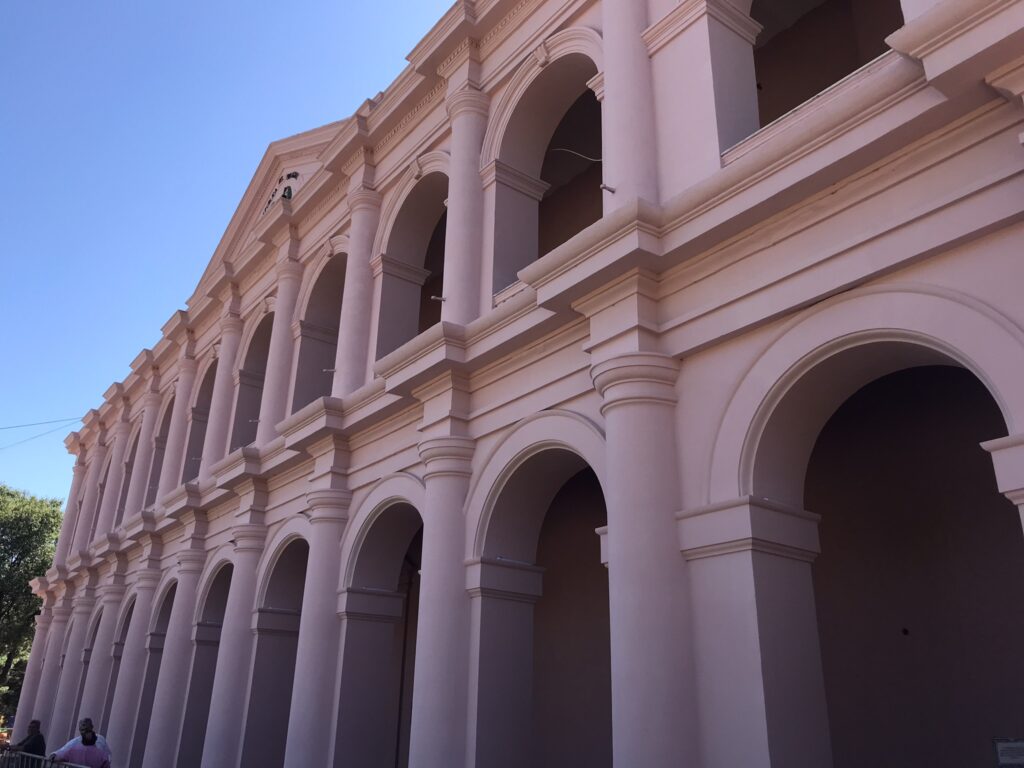
Asuncion city centre had a strange feel due to the presence of a large and notorious slum nearby. Barrio Chacarita, originally a flood plain but now home to 20,000 poverty-ridden residents, sits nestled between the Costanera (river-front) and Congress building. Police guard the entrances to the neighbourhood and you will be prevented from entering, it’s well known as a crime hotspot and outsiders are strongly discouraged from entering the barrio without a local guide.
With slums encroaching on the city centre, most of the wealthier residents of Asuncion have left for more affluent suburbs like Las Lomas. As businesses have moved away, many Paraguayans now avoid the centre of Asuncion altogether. The police presence is starkly visible, often with more police officers than people especially after dark and we personally witnessed drug users roaming the streets. Despite this, the city centre didn’t feel too unsafe due to the very visible police presence on every corner. Apart from the city centre and its national monuments, in all honesty there isn’t much for tourists to do in Asuncion, you can visit most attractions in a day.
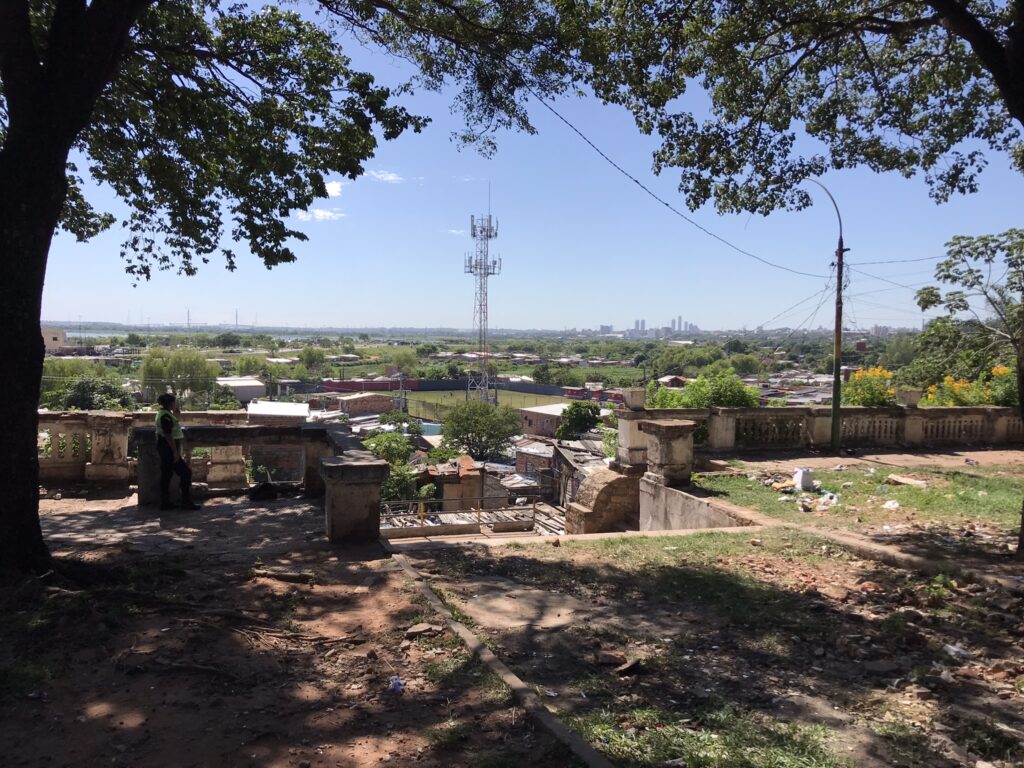
Entrance to the Chacarita – take note of the policewoman guarding the entrance
Accommodation
Excelsior Inn – opposite the Excelsior Mall which has a Burger King, KFC and Pizza Hut. This hotel was one of my favourites of our South American trip, it’s a grand old hotel stuck in the past with an impressive black marble staircase covered in a decades-old once-decadent rug, with dark wood panelling and rickety lifts. The bedrooms are huge and all the décor is from the hotel’s golden age. The lobby of the hotel is lined with photos of former dignitaries and leaders who visited in bygone years. We even spotted a photo of England’s Prince Philip visiting in his youth! There’s also a large swimming pool to the rear. The all-you-can eat breakfast is splendid, served by dapper waiters in full dress, tails and all! Staying here felt like we were stepping back in time. The prices are fantastic here too.
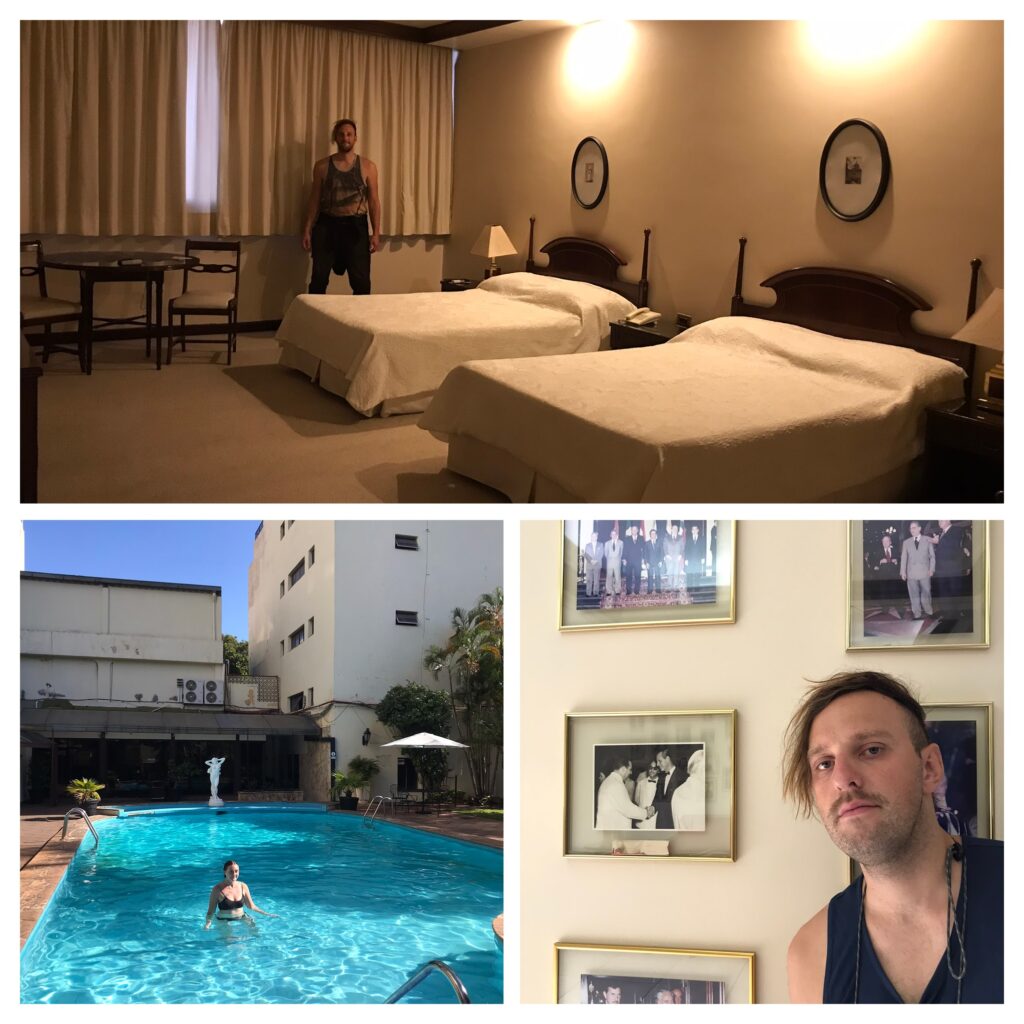
Dan and a young Prince Philip at the Excelsior Inn
Foodie Places
KFC in the Excelsior Mall – I wouldn’t usually recommend an international fast food joint but this was hands down the best KFC I’ve ever eaten, there was virtually nobody else in the store so they cooked our order especially.
Negroni Sky Bar – we only enjoyed a tipple here but the view of the Asuncion skyline and suave atmosphere is unbeatable.
Bolsi – serves traditional comfort food, it has a huge menu with lots of dishes to choose from, I really recommend the chicken caesar wrap, it was amazing! We loved the cochina here too. This was the first restaurant we visited in Paraguay and I was a bit confused about how to order, you’re seated at a crescent shaped bar and the waiters seemed too busy to take our order, I tried to order at the till only to be told that you need to order with the waiters in the middle of the crescent bar. Once we figured this quirk out it was smooth sailing. If you want to eat at a normal table (i.e. not at the crescent shaped bar) you must wear a long-sleeved shirt, we got caught out by this archaic rule.
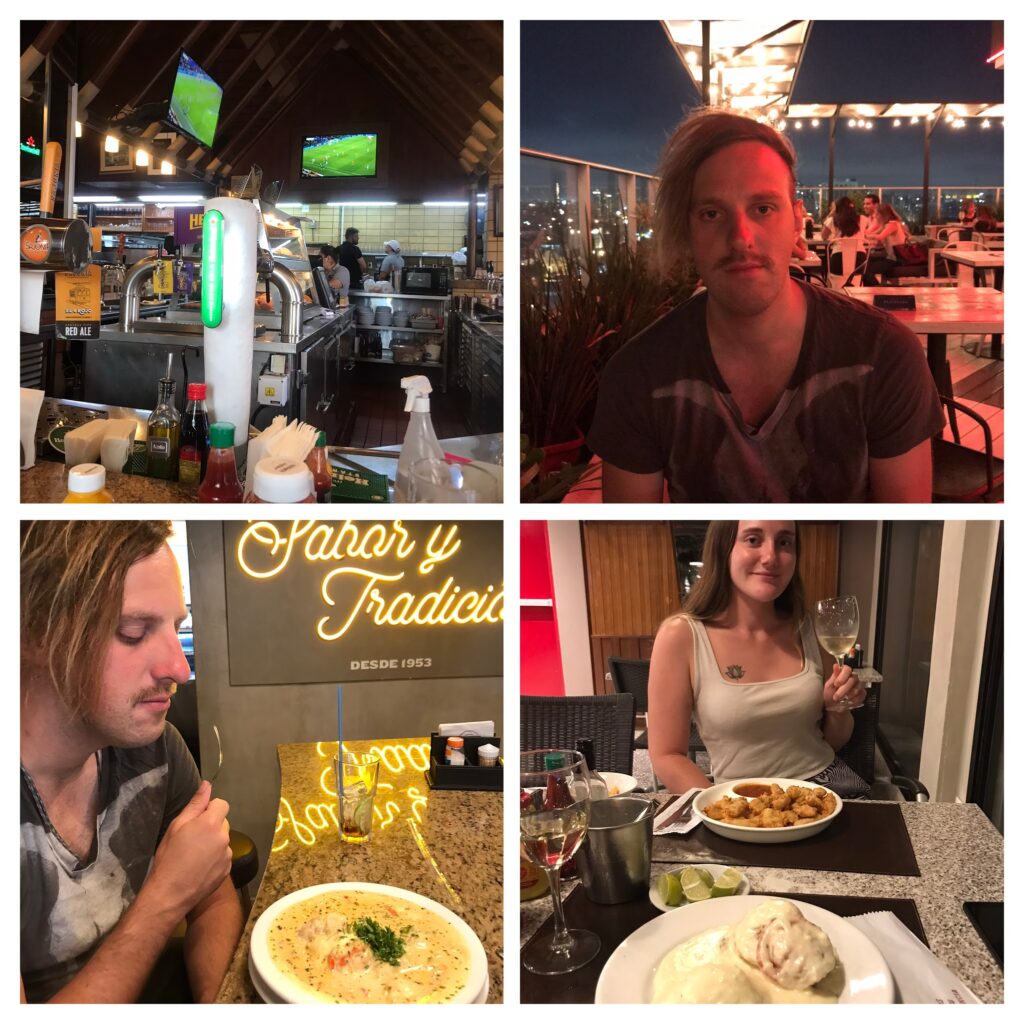
Lido Bar – another traditional place to eat, we discovered that there’s an upstairs dining area which doesn’t have a silly dress code. We liked trying Surubi, which is a local river fish and delicacy here.
Bar Casa Clari – we only popped in for some water but the view from the balcony of the Palacio de López was great!
El Café de Acá – a quirky cafe in a nicer neighbourhood which was a good place to try some tereré (cold mate), you have to get an Uber to get to this cafe from the centre. We met up here with a Paraguayan friend we’d met on the Galapagos, she’d lived in Asuncion from most of her life and gave us a mini tour of the surrounding Las Lomas neighbourhood which was very different to the centre of Asuncion.
Activities
Free walking tour – we could only find one free tour advertised anywhere online and we were the only ones on the tour but this by far was the best thing to do here, it was insightful and useful for recommendations and understanding the history of Paraguay and Asuncion. During the tour we were lucky enough to stumble onto a military ceremony at the Palacio de Lopez marking the arrival of the new Italian ambassador to Paraguay.
Costanera walk – we took a short walk along the coastal river path but turned back when we got too close to the Barrio Chacarita.
Estación de Ferrocarril – the old British-built railway station, you can wander in for free but if you want to visit the museum you have to pay an entrance fee, we opted for the free option.
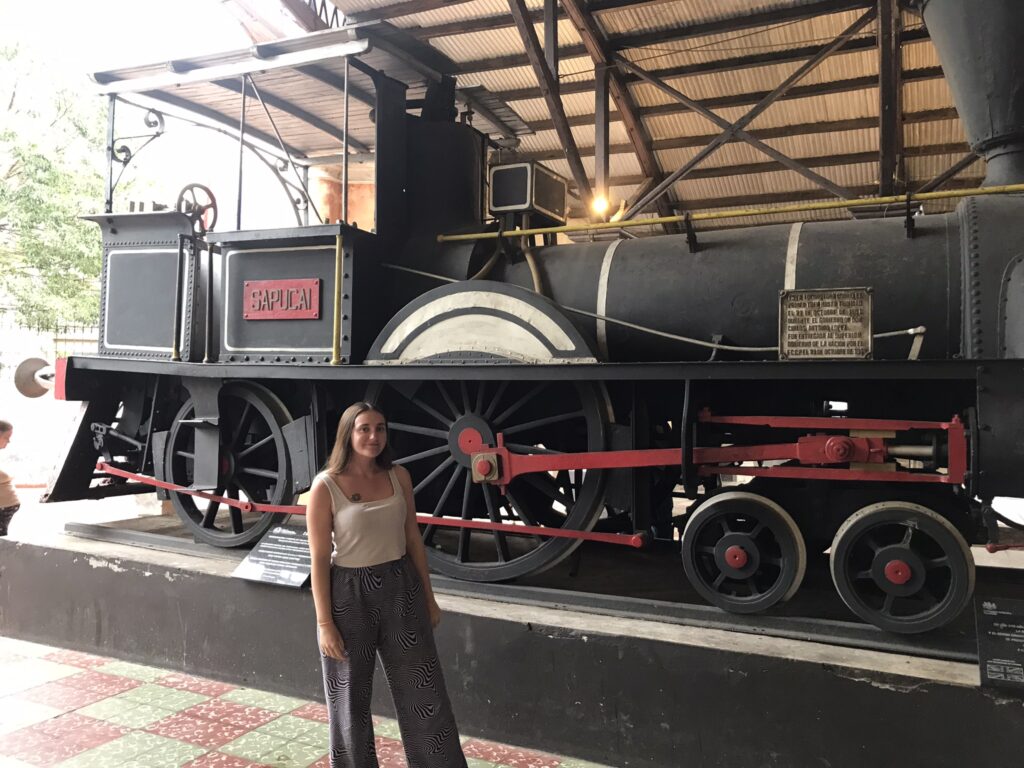
Museo Memoria de la Ciudad, Independence House Museum – as always Dan visit the place where the independence accords of the country were signed.
Filadelfia
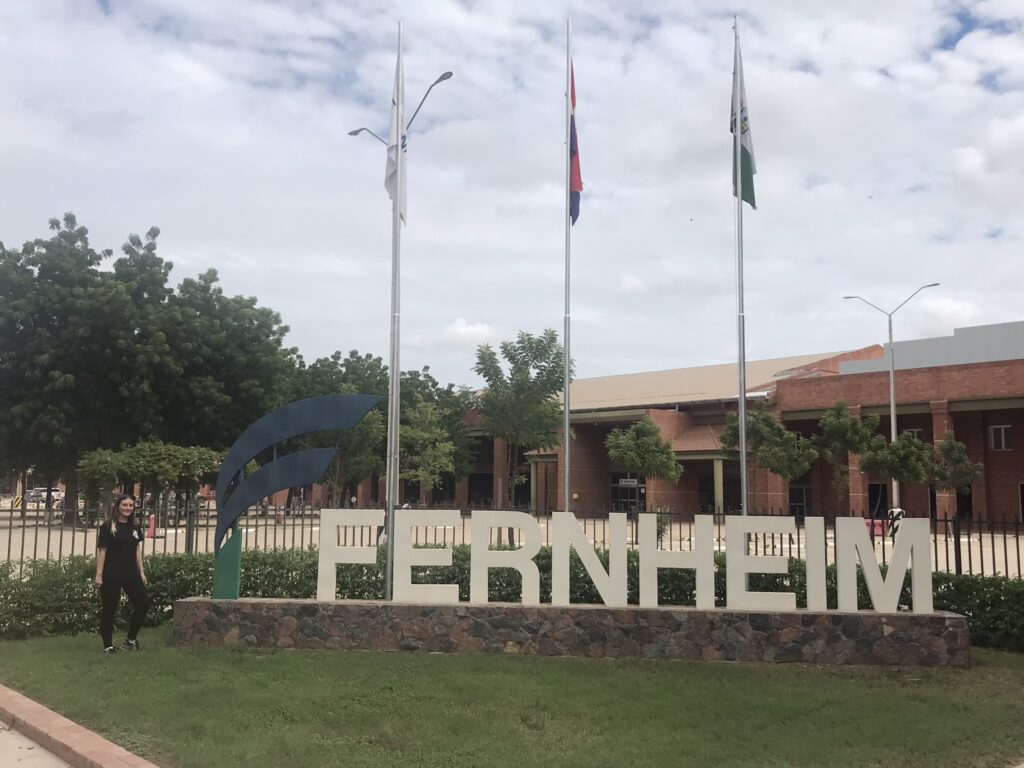
On the spur of the moment, we decided to head deep into the Chaco region and visit the Mennonite community of Filadelfia. We didn’t know what to expect. All we knew for certain was that it was a German-speaking religious community located deep in the ‘green hell’, an apt description of the Chaco region due to its heat and inhospitable terrain. Our only source of practical information on Filadelfia came from a solitary blog post which was over ten years old. After a lot of trawling through Spanish-language Facebook posts to try and find transport information and timetables we turned up at the Asuncion bus station not even 100% sure if there was a bus running to Filadelfia, as it turned out the bus was running as scheduled operated by the company ‘NASA Golondrina’.
I definitely wasn’t expecting Filadelfia to be the way it was. Huge ranches of tamed Chaco land. Quaint little German-style houses with white picket fences and manicured lawns with blond-haired children playing in the gardens, it was strange. Filadelfia is so remote yet there was order and normality in the everyday lives of the residents. The Mennonites drove big white trucks, lived in normal houses, dressed in modern clothes and shopped in the local supermarket.
As I got to learn more about the community, I discovered that the Mennonites fled Europe, some via Russia and China, and sought refuge to practice their religion and form their own societies away from persecution or the political constraints of their native countries. Each community in the region was formed by different collections of families who emigrated to Paraguay in separate waves of immigration, each following a different migration route before finally ending in Paraguay. The Mennonite communities founded co-operative companies which controlled most aspects of their towns and allowed them to be self-sufficient, with Filadelfia’s company being called ‘Fernheim’. I was fascinated to discover that the descendants of the original founders spoke Plautdietsch, a dialect of German spoken by very few people in the modern day.
When we first arrived the residents seemed slightly wary of us, it was abundantly clear that they weren’t used to foreign visitors, especially backpackers. However we visited the tourist information centre and were given a warm welcome by the lady who worked there. She spoke English and gave us leaflets and a free History of Fernheim book as well as advising us about the handful of small museums that the Mennonites had opened in the town.
It was fascinating to learn in the Koloniehaus about how a group of Mennonites, through hard physical work and labour were able to establish a successful, thriving colony in such a remote area of Paraguay with very limited supplies and no direct transport or roads to the settlement. The curator of the Koloniehaus was very friendly and explained about the settlers and hardships they endured, he only spoke Spanish and Plautdietsch so we didn’t understand everything but it was nonetheless great to speak to a Mennonite descendent of one of the town founders. We also visited the Jakob Unger Museum. This museum contained a vast collection of taxidermied exotic animals. If you’re squeamish about stuffed animals, I recommend giving it a miss. Both museums have free entry. FYI, all museums as well as the Fernheim supermarket are closed on Sundays as the entire town effectively shuts down.
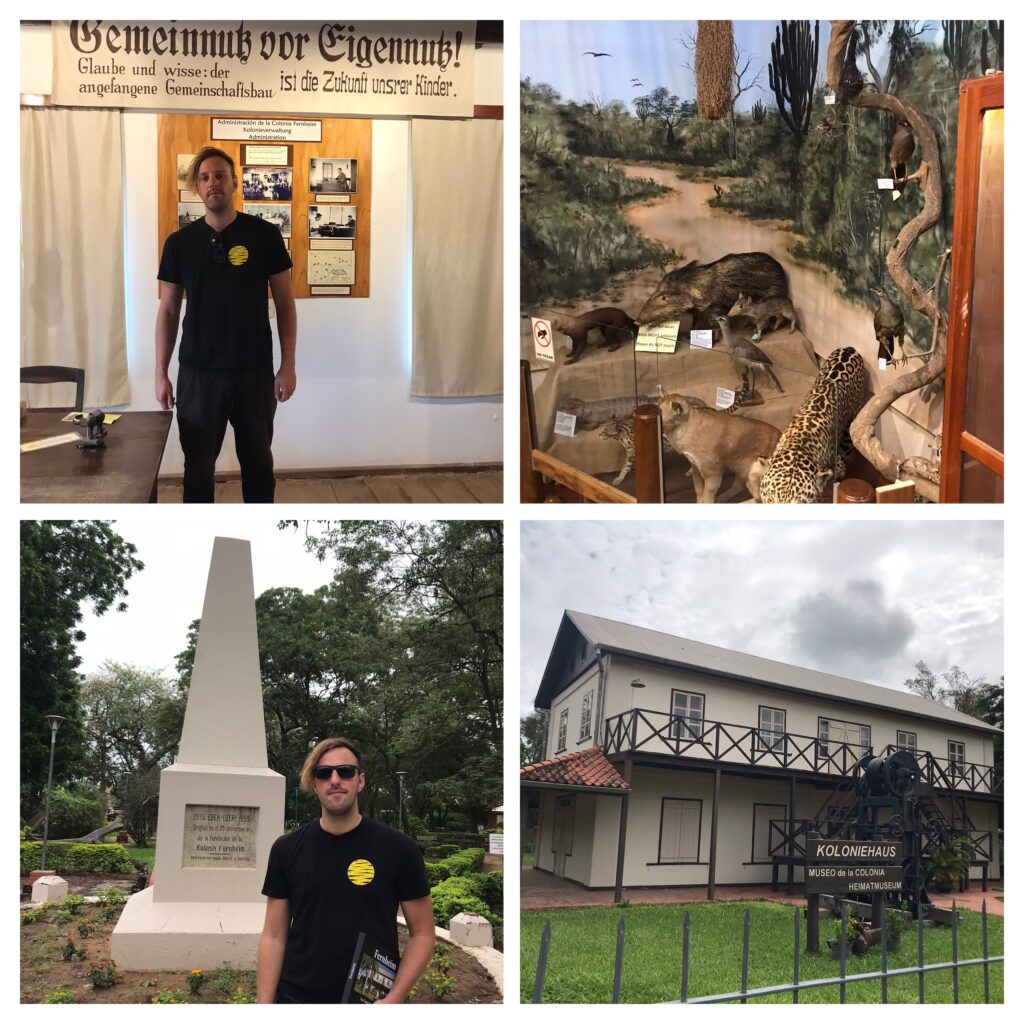
Some of the main attractions in Filadelfia
I was particularly interested in the relationship between the local indigenous people and the Mennonites. The message that Fernheim want to portray is that there is a harmonious relationship between the two communities, the colonists brought electricity, build roads, houses and schools, water supply and jobs to the local area. It is clear to see that the Mennonites have been successful, they have big ranches and big trucks, but I can’t be sure either way if the local indigenous residents have fully reaped the financial rewards available to the Mennonite community. It is important to note that most businesses are owned by the Fernheim co-operative, almost like a monopoly. Fernheim owns hotels such as Hotel Florida, the supermarket, petrol stations, restaurants etc, all of which employ local indigenous people but with the ownership and profits going back to the company and its Mennonite members. It was really weird to walk around a huge, modern, air-conditioned supermarket owned by Fernheim, selling German goods alongside branded products – the supermarket in Filadelfia was one of the biggest, best and most well-stocked I visited anywhere in South America.
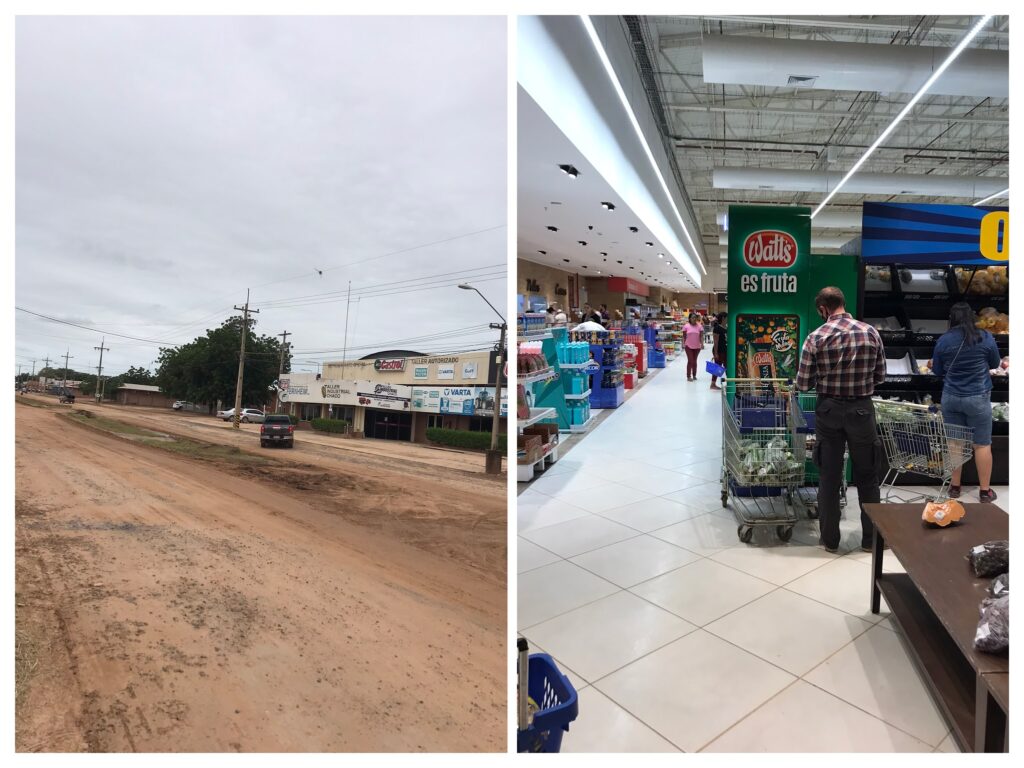
Dirt roads and modern supermarkets – that sums up Filadelfia perfectly
Accommodation
Hotel Safari – we couldn’t find any accommodation on booking.com or our regular platforms, however we were able to whatsapp Hotel Safari and arrange a room. The room was better than expected and free breakfast was an unexpected perk. Be prepared for wildlife to invade, we found what we thought was a frog doorstop which turned out to be a real toad! We also found crickets and large beetles in the corridors of the hotel.
Foodie Places
Resto Grill & Catering Girasol- open on a Sunday, hooray! We became a bit concerned that we wouldn’t find anywhere to eat on a Sunday but this place was open! It was our first introduction to the world of kilo buffets which are common in Paraguay and Brazil, over the next couple of weeks we became hooked, converts to the kilo buffet life. The basis of the kilo buffet is that you walk into the restaurant and grab a plate, you then fill your plate with as much food as you want from the buffet. After you’ve piled high, head to the counter and place your plate on the scales, they will record the weight and in most restaurants you pay at the end. Don’t worry, they know how much your plate weighs so will deduct that from the final weight. Enjoy! And be aware that you pay for the weight of your food so I would recommend avoiding heavy food like mash potato or meat with bones in as you pay for the bones too! This buffet was really tasty, in my opinion it’s the best place to eat in Filadelfia.
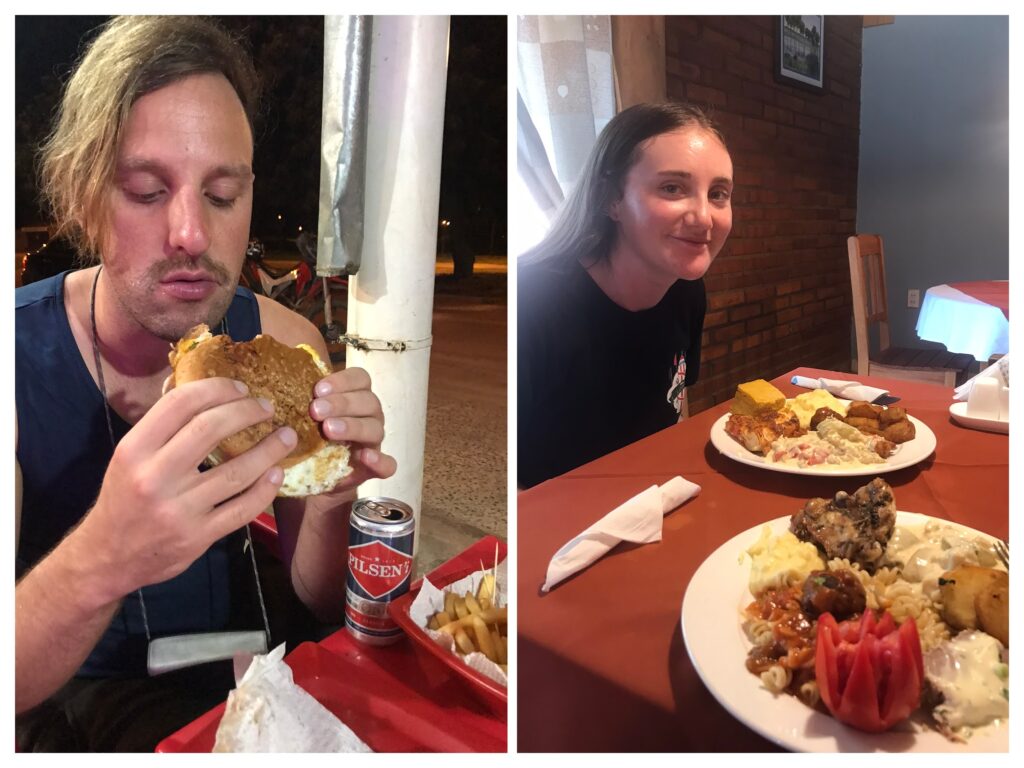
Lomitería Wilaõ – the location on google maps is incorrect, it’s actually next to Classic Moto’s SRL on Avenue Hindenburg. They serve dirty burgers, lomito arabe (sort of like a kebab wrap), chips and cold beer. A good place to head to if you arrive into Filadelfia late, the food is cheap and cheerful.
Activities
Koloniehaus & Jakob Unger Museum, as mentioned above
Walk to Fortín Trébol – we walked from Filadelfia along the main road to Fortin Trebol, we saw so many colourful birds. The walk took around an hour down the main highway, there wasn’t any path for most of the way and when we arrived the fort was closed for entry but was visible over the fence. There was also a grave marker for fighters from the Chaco War nearby along this route.
Night Safari with Marilyn around Hotel Campestre Iparoma – we found Marilyn’s phone number on a leaflet from the tourist information centre, she arranges safaris around her ranch and tours to Salty Lagoon nearby. Marilyn spoke very good English and was very friendly, answering all my strange questions about Mennonites and life in the Chaco. We saw a tarantula, grey fox, a very poisonous snake and an anteater whilst driving around in her jeep. I highly recommend getting in touch with Marilyn if you want guidance on what to do in Filadelfia or want to arrange a tour, you can also stay at her ranch!
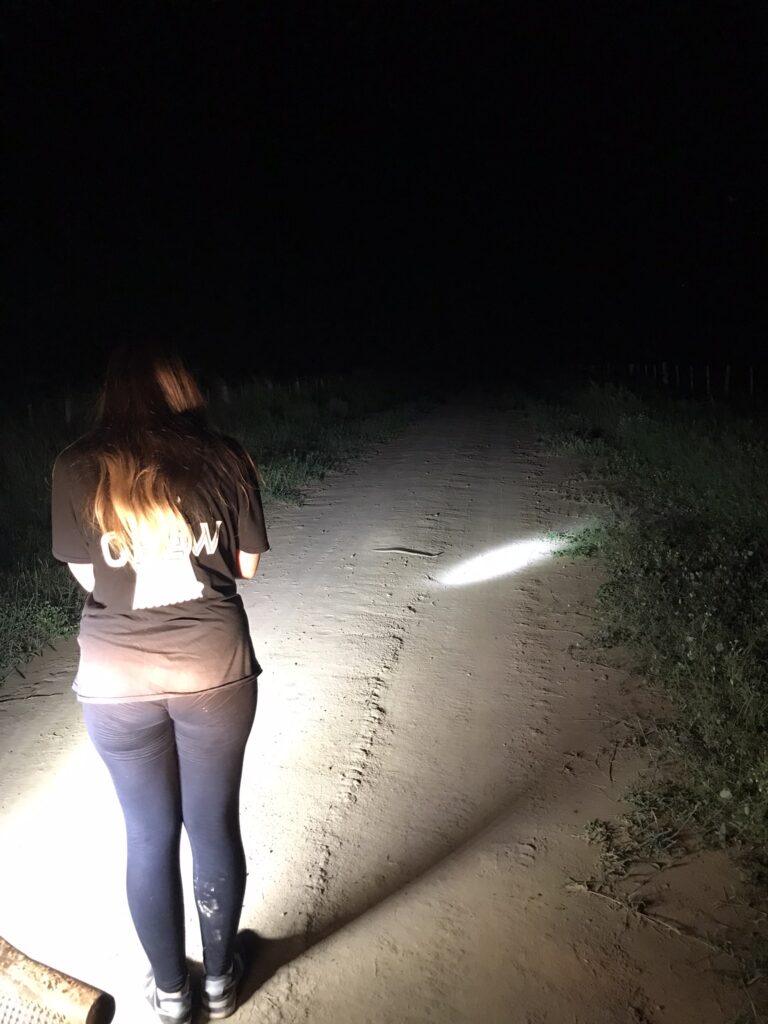
Facing off with a very dangerous snake during the night safari
Walk around Parque Serenidad – a very small wetland park which is located just off Avenue Hindenburg and was an interesting place to try to see some wildlife and listen to the strange sound of the local frogs!
Encarnacion
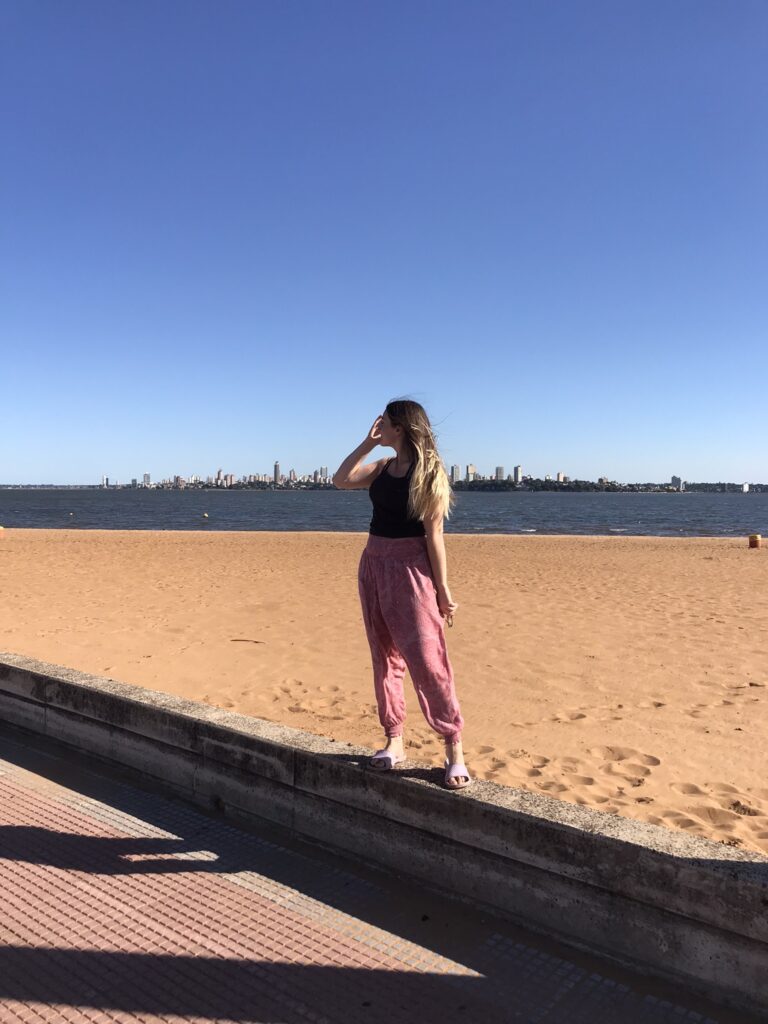
The river beach in Paraguay, the city of Posadas in Argentina is in the background
We got the feeling that Encarnacion was a resort city, busy during the peak season but a ghost town during the low season. We happened to go there when it was very slow.
Accommodation
Le Club Resort Hotel – cheap, resort-style hotel with swimming pool and a gym
Foodie Places
Tio Miguel Buffet – best buffet in Encarnacion, most kilo buffets in Paraguay and Brazil including Tio Miguel only open for lunch so watch out for this.
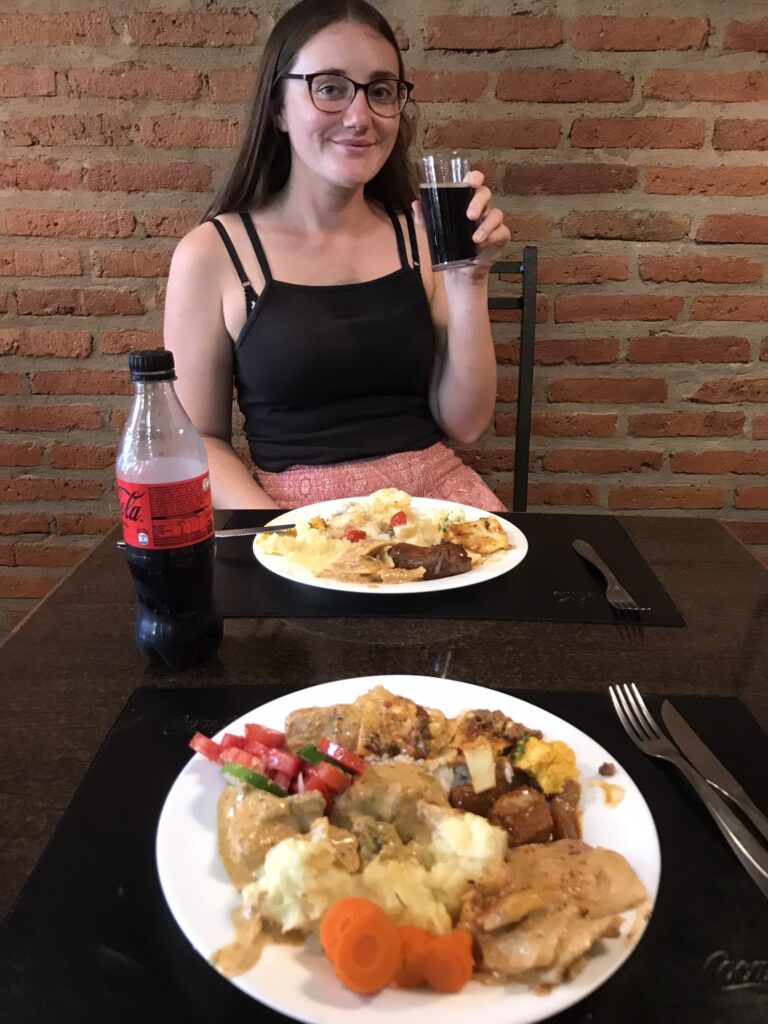
Piccola Italia Encarnacion – nice Italian close to our hotel, it’s not very authentic but serves pizza, pasta and lasagne
Activities
Playa San Jose – a very nice river beach, it’s hard to believe that the beach isn’t on the sea, there’s great views of Posadas city (across the border in Argentina) from the beach. There’s lots of restaurants and bars close to the beach. We met a very friendly dog at the beach who followed us all the way back to our hotel. I won’t forget his little nose poking through the closing doors of the hotel lobby as he wasn’t allowed in. I bought a sausage from the petrol station for him.
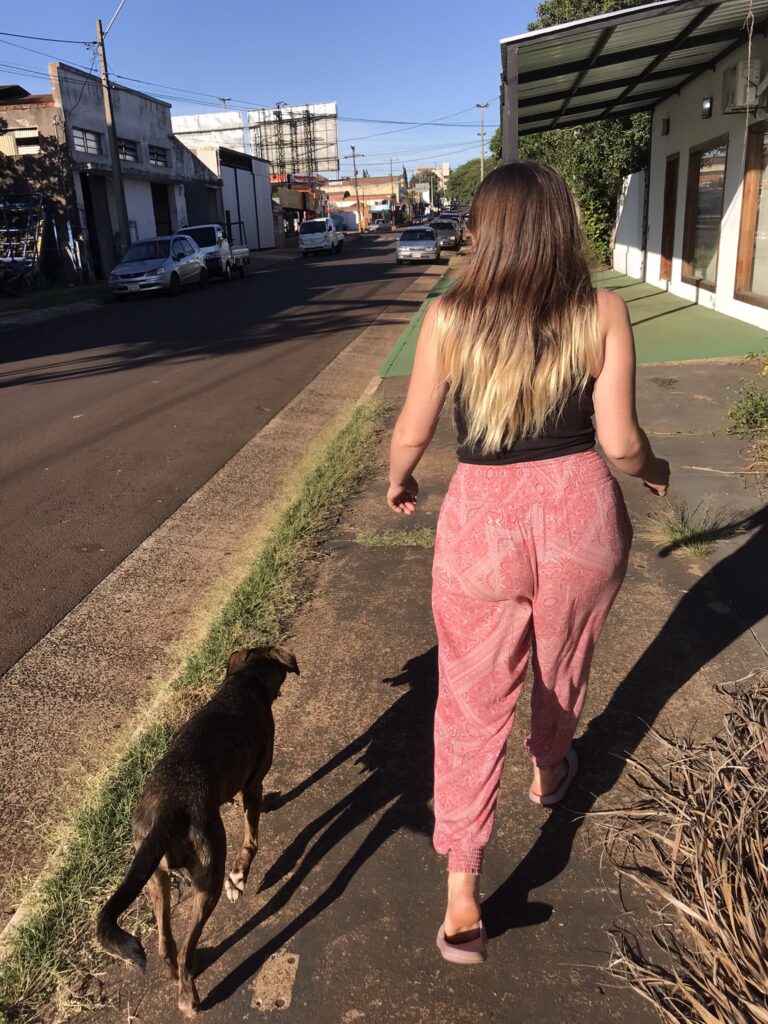
Making friends in Encarnacion
Jesuit ruins at Trinidad – to get here we jumped on a bus at Encarnacion bus station to the town of Trinidad, make sure you follow the route on google maps as you need to ask the bus driver to stop otherwise he might continue driving. The driver will drop you on the main road (route 6), it’s best to talk to the driver before you get on the bus and say ‘Jesuit ruinas en Trinidad’ or similar just to make sure he drops you off in the right place. I can honestly say that the ruins themselves were the least crowded UNESCO World Heritage site I’ve ever been to, there was literally no one else there, we had the whole complex to ourselves to explore at our leisure. First you can watch a short documentary which explains about the history of the Jesuit mission in Paraguay and how the indigenous people/culture were involved with the religious community and building of the church and living quarters. Then you can explore the two churches, bell tower, workshops and terrace living quarters. Overall I highly recommend visiting if you find yourself in Encarnacion. The ticket that you buy also gains you entry to two other Jesuit sites, one nearby and another which is much further away. These other two ruins are not easily accessible by public transport and so we didn’t visit them. If you have a car it’s possible to visit all three ruins much more easily than taking public transport like us. Heading back to Encarnacion from Trinidad we walked back to the main road (route 6) and waited at the side of road opposite to where we had originally been dropped off by the bus, after waiting for a while with a beer and flagging down a few passing buses one eventually stopped and took us back to Encarnacion.
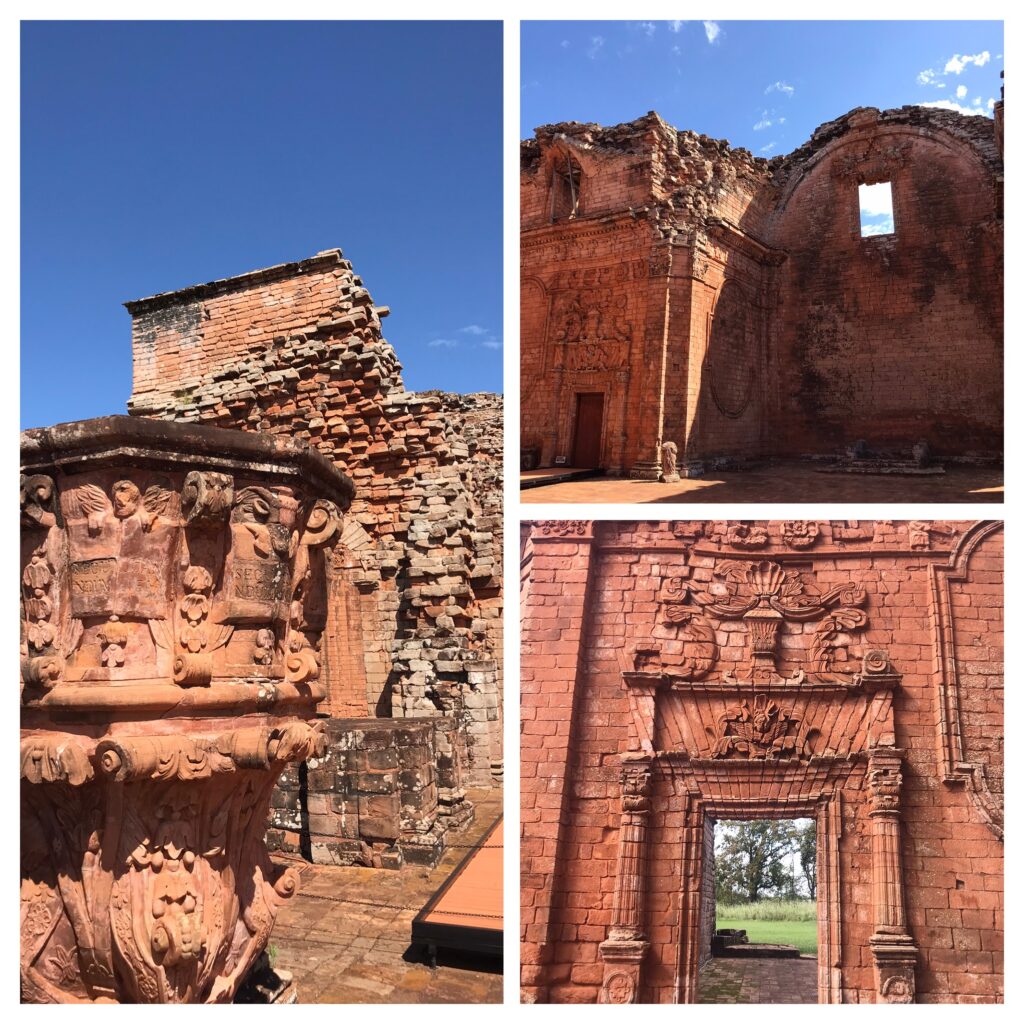
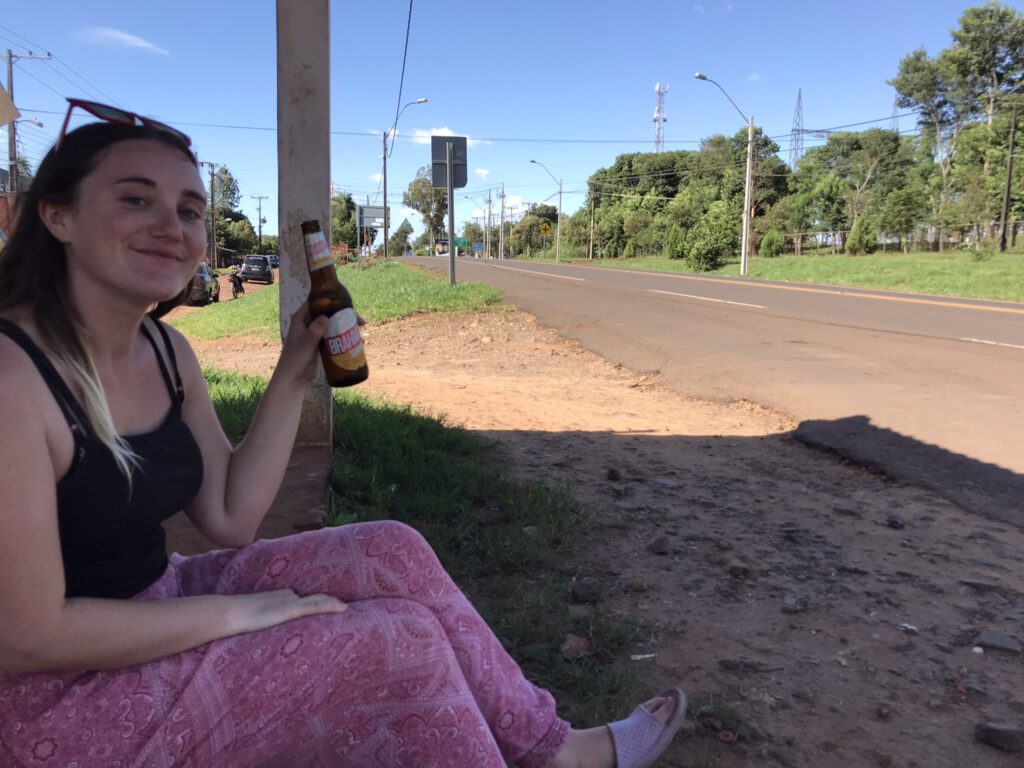
Sometimes all you can do is drink a beer and wait by the roadside, hoping that the bus will come
